Mastering Air Fryer Chicken Wings: A Comprehensive Guide
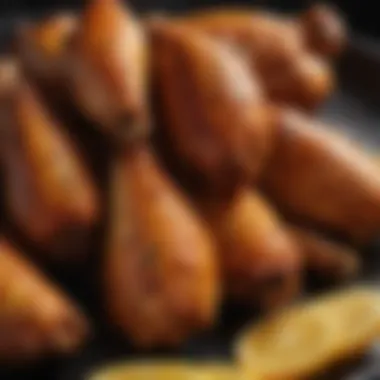
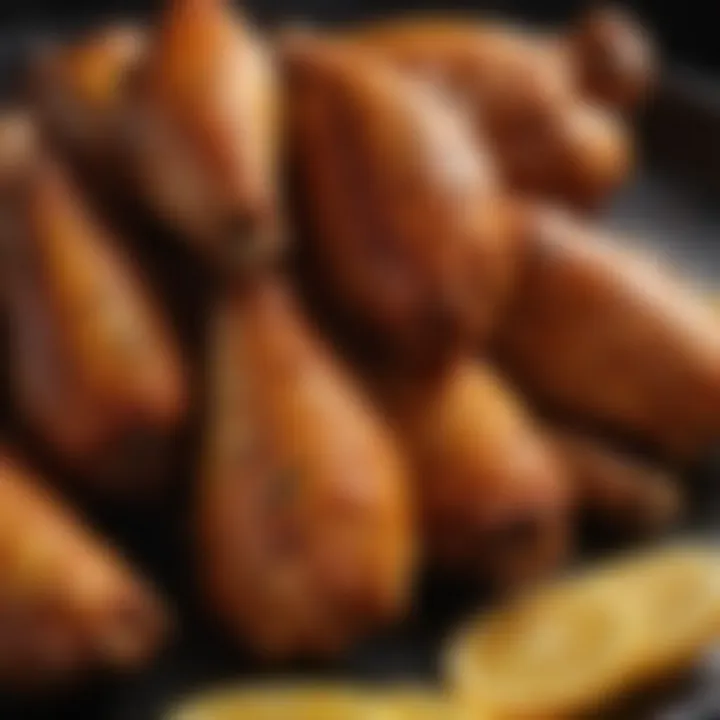
Intro
Air frying has become a popular method for preparing food, notably chicken wings. This technique offers a healthier alternative to traditional frying, retaining a rich flavor while minimizing excess oil. The air fryer circulates hot air, delivering a crispy exterior without the need for heavy fats.
In this guide, we will delve deep into air frying chicken wings, discussing everything from selecting the best ingredients to troubleshooting common issues. We will also cover various cooking techniques and seasoning options, ensuring that both novice and skilled cooks can find valuable information.
Air fryer chicken wings are not just delicious; they lend themselves well to diverse flavors. Whether you prefer spicy sauces, tangy marinades, or a simple dry rub, each option enhances the natural taste of the chicken. This guide aims to equip you with the knowledge to prepare perfect wings, every time.
The simplicity and speed of air frying make it an ideal choice for gatherings. With the right preparation and understanding of the cooking process, it is possible to impress family and friends with minimal effort.
Key Points to Discuss
- The advantages of air frying over traditional frying methods
- Selecting quality chicken wings and ingredients
- Step-by-step preparation and cooking techniques
- Various seasoning and flavoring options
- Addressing common cooking challenges
- Suggestions for serving and storing leftovers
This comprehensive exploration will not only enrich your cooking experience but also elevate your gatherings. Whether it is for a casual get-together or a formal occasion, mastering air fryer chicken wings adds significant value to your culinary repertoire.
Prolusion to Air Frying
Air frying represents a modern technique that has gained popularity among health-conscious cooks. This section emphasizes the significance of understanding how air frying works as a method for preparing delicious meals, particularly chicken wings. The air fryer utilizes hot air circulation to cook food, providing a method that aims to replicate the texture and taste achieved through traditional frying without the need for excessive oil.
With rising interest in healthier cooking methods, mastering the air fryer can transform a simple recipe into a culinary experience that retains flavors while reducing fat content. Understanding this technology can be the first step toward making thoughtful choices in the kitchen.
What is an Air Fryer?
An air fryer is a kitchen appliance designed to cook food by circulating hot air around it. It works on the principle of convection, which distributes heat evenly. This process results in food that is crispy on the outside and tender on the inside. Unlike traditional frying methods that submerge food in oil, air fryers use minimal or no oil, making them a practical option for those looking for healthier cooking options.
The versatility of an air fryer is another notable aspect. It can handle a wide range of foods, from vegetables to meats and, especially, chicken wings. This makes it a valuable addition to any kitchen.
Benefits of Using an Air Fryer
Air fryers provide several advantages that appeal to various cooking preferences. Some of these benefits include:
- Healthier Cooking: The primary advantage is the reduction in oil used, which translates to lower fat and calorie intake.
- Crispy Results: Air fryers produce a crispiness comparable to deep-fried food, satisfying the desire for texture without the guilt of excess calories.
- Convenience: These appliances often have preset cooking functions, simplifying meal preparation and allowing users to achieve consistent results without guesswork.
- Time Efficiency: Many air fryers preheat quickly and cook food faster than traditional ovens, making them ideal for busy individuals or families.
- Safety: With less hot oil involved, there is a lower risk of burns and other kitchen accidents.
"Using an air fryer is a smart choice for those seeking to balance flavor and health in their diets."
Overall, these benefits make air frying an attractive option for anyone wanting to prepare various dishes while maintaining nutritional integrity. Understanding these fundamentals sets the stage for mastering air fryer recipes, particularly chicken wings.
Understanding Chicken Wings
Understanding chicken wings is crucial for anyone looking to master the art of air frying. Chicken wings are not only popular in many cuisines but are also versatile. They can be prepared in various ways, and an air fryer provides a unique approach by ensuring they remain moist while achieving a crispy texture. Different cooking styles, flavors, and preparation techniques can influence the outcome and experience of enjoying chicken wings.
Different Types of Chicken Wings
There are several types of chicken wings, which can affect flavor and preparation methods. The most common varieties include:
- Traditional Wings: These have two main sections, the drumette and the flat. Traditional wings are usually what most people think of when ordering wings at a restaurant. They are perfect for sauces and deeper flavors.
- Wing Dings: These are typically smaller and may come without a bone. They are often breaded and fried. While not as widely known, they offer a crunchy texture.
- Boneless Wings: These are typically made from chicken breast meat that is cut into pieces and breaded. Although technically not wings, they are popular for their ease of eating.
- Party Wings: These are usually smaller wings sold in larger quantities. They can also contain a mix of wing types which adds variety to any gathering.
Choosing the right type of wing is important. Depending on the preparation, some might lend themselves to more robust flavors while others may be better suited for lighter, more delicate marinades.
Nutritional Profile of Chicken Wings
Chicken wings have distinct nutritional benefits. They are a good source of protein, which is beneficial for muscle repair and growth. Additionally, depending on how they are prepared, chicken wings can vary in fat content. When air frying, the reduced oil usage can make them a healthier option compared to traditional frying methods.
Here are some general nutritional facts about chicken wings:
- Protein: Approximately 20 grams of protein for a serving of three wings.
- Fat: Traditional chicken wings can have about 10-15 grams of fat, varying based on cooking method and added ingredients.
- Calories: A serving of chicken wings can range from 300 to 400 calories, depending on the preparation and sauces used.
When preparing wings, consider the balance between enjoying their delicious flavors and being mindful of the nutrition they provide. You can enhance their profile by choosing healthy cooking techniques and fresh ingredients.
Selecting Quality Ingredients
Choosing the right ingredients is essential for making delicious air fryer chicken wings. The quality of your components can significantly affect the taste and texture of the final product. Using fresh, high-quality chicken wings ensures that the flavor will be vibrant and enjoyable. Additionally, appropriate seasonings and marinades enhance the overall experience, making each bite satisfying. In this section, we will discuss how to select fresh chicken wings and explore the essential seasonings that can elevate your dish.
Choosing Fresh Chicken Wings
When it comes to chicken wings, freshness is paramount. Fresh wings not only taste better but also have a firmer texture which is crucial for achieving that perfect crispiness in the air fryer. Look for wings that have a pinkish hue, with no discoloration or unpleasant odor. The skin should be smooth, not slimy, signifying that they have been properly handled.
- Purchase from Reputable Sources: Buy your chicken wings from trusted local butcher shops or farmers markets. This often ensures a higher standard of meat.
- Check Packaging: If buying packaged wings, verify the sell-by date. Freshness is key. The wings should be vacuum-sealed and there should be no excessive liquid in the package.
- Consider Organic Options: Organic chicken wings may be a healthier choice since they come from chickens raised without antibiotics or hormones.
Investing time to choose the right wings can dramatically improve your air frying experience.
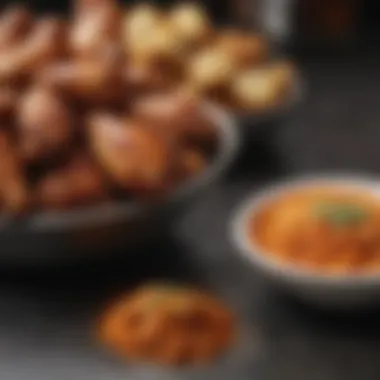
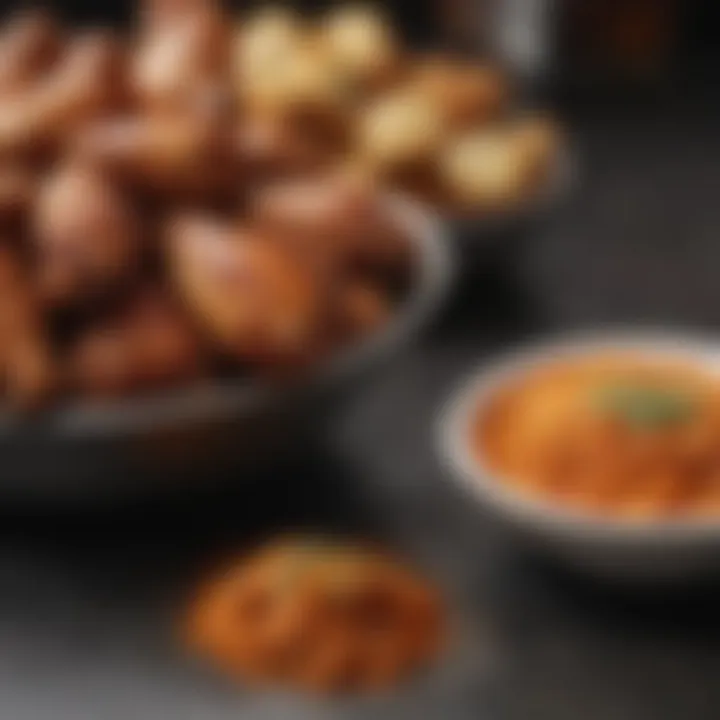
Essential Seasonings and Marinades
Once you've selected fresh chicken wings, the next step is to season them properly. Seasoning is what gives wings their distinct flavor, allowing you to customize your dish according to your preferences. A well-thought-out combination of spices and marinades can transform a basic wing into a gourmet delight.
- Salt and Pepper: These are the fundamental seasonings. They enhance the overall taste of the meat.
- Dry Rubs: Consider using dry rubs composed of spices like paprika, garlic powder, onion powder, and cayenne pepper. A simple mixture can add layers of complex flavors.
- Marinades: Marinades can be a game changer. Combining oil with vinegar or citrus juice and spices lets the flavor permeate the meat. Options such as soy sauce for an Asian twist or hot sauce for a spicy kick are popular.
- Time Matters: Allow your wings to marinate for at least 30 minutes, or even overnight for deep flavor infusion.
In incorporating these considerations into your preparation, you ensure that your air fryer chicken wings will not only be tasty but also appealing to serve. Taking the extra steps in selecting quality ingredients will always yield rewarding results.
Preparation Techniques
In the realm of culinary arts, preparation is not merely a preliminary step. It serves as the foundation upon which success is built, particularly when it comes to mastering air fryer chicken wings. Proper preparation enhances flavor and ensures the cooking process yields optimal results. When chicken wings are handled correctly, it significantly improves texture and overall enjoyment.
Cleaning and Trimming Wings
Cleaning and trimming chicken wings is a crucial task that directly affects cooking efficiency and the final presentation. Dirty wings can introduce bacteria into your meal. Therefore, always start by rinsing the wings under cold running water. This removes any residual blood, feathers, or other impurities.
Next, trimming is essential. Removing excess fat and wingtips, which can burn during cooking, leads to a cleaner taste and a tidier presentation. For air frying, you should split the drumettes from the flats, if preferred. This process not only aids in even cooking but also makes it easier to serve.
Marinating for Maximum Flavor
To truly elevate the flavor profile of your chicken wings, marination is a vital step. This process allows the seasonings to permeate the meat, enhancing taste and juiciness. You can use a variety of marinades that suit your desired flavor profile.
Common ingredients for effective marinade include:
- Soy sauce
- Honey or brown sugar
- Garlic and ginger
- Lemon juice or vinegar
- Various spices like paprika or black pepper
For maximum absorption, marinate the wings for at least 30 minutes, though several hours or overnight are ideal. The key is to balance flavors, ensuring no single aspect overwhelms the others. Experimenting with different combinations can lead to surprisingly pleasant outcomes that may become your favorites.
Cooking Chicken Wings in the Air Fryer
Cooking chicken wings in the air fryer is a pivotal part of mastering the art of preparing this beloved dish. This method not only speeds up the cooking process but also maintains a delightful crispiness without the excessive oil needed for traditional frying. Air frying makes it possible to achieve that golden-brown exterior that everyone loves, while keeping the inside juicy. Understanding the nuances of this technique can greatly enhance the flavor and texture of your wings, making them a true highlight in any meal.
Preheating the Air Fryer
Preheating the air fryer is an essential step that many home cooks often overlook. This process helps to create a stable cooking environment which ensures that the chicken wings are cooked evenly from start to finish. By preheating the appliance, you are allowing it to reach the desired temperature before the wings go in. This feature can prevent the skin from sticking and encourages optimal browning. Plan for a short preheating period of about 3 to 5 minutes, depending on the model of your air fryer. To confirm the air fryer is ready, you can check for a heating indicator light or simply gauge by the warmth of the appliance.
Setting Temperature and Time
Setting the appropriate temperature and cooking time is crucial for perfect wings. Generally, a temperature of 375°F to 400°F works well for achieving crispy results. The exact setting can depend upon the desired doneness as well as the size of the wings. For instance, larger wings may require a slightly lower temperature to cook thoroughly, while smaller wings can be cooked at a higher temperature for a shorter duration.
A useful guideline to follow is to cook the wings for approximately 25 to 30 minutes. It is advisable to flip them halfway through the cooking time to ensure they crisp up evenly on all sides. This strategic turning combined with a high temperature will provide that sought-after crunch on the outside, while preserving juiciness on the inside.
Cooking Process Step-by-Step
To streamline the process of cooking wings in the air fryer, here’s a simple step-by-step guide:
- Prepare the Wings: Begin by cleaning and patting dry your chicken wings. This helps to ensure they achieve a nice crispness.
- Season Appropriately: Season or marinate your wings as desired. This can include salt, pepper, or your favorite spice blends.
- Preheat the Air Fryer: Set your air fryer to the desired temperature and allow it to preheat for 3 to 5 minutes.
- Arrange the Wings: Place your seasoned wings in the air fryer basket in a single layer. Avoid overcrowding to maintain proper air circulation.
- Monitor Temperature and Time: Set the timer for 25 to 30 minutes. Flip the wings halfway through for even cooking.
- Check for Doneness: Use a meat thermometer to ensure the internal temperature of the wings has reached 165°F.
- Serve Immediately: For the best texture and flavor, serve the chicken wings right after cooking.
By following these steps closely, you can master the cooking of chicken wings in an air fryer, leading to results that are consistently satisfying.
Achieving Optimal Crispiness
Achieving optimal crispiness is a critical aspect of cooking chicken wings in the air fryer. The allure of crispy wings lies in their texture and flavor. Well-cooked wings have a delightful crunch on the outside while remaining juicy on the inside. Proper technique and ingredient choices play pivotal roles in reaching this outcome.
A crispy exterior elevates the sensory experience, enhancing each bite. It also gives the wings an appealing appearance, making them enticing to serve at gatherings or casual meals. Not only does the texture captivate diners, but it also helps to lock in the flavors of the seasonings and marinades used. Crispiness contributes to the overall satisfaction of enjoying chicken wings, and achieving it is often the objective for home cooks.
Basting for Flavor and Texture
Basting chicken wings while they cook adds layers of flavor and assists in achieving that desired crispy texture. This technique involves brushing or drizzling a liquid, often a marinade or oil, over the wings at intervals during the cooking process.
- Flavor Enhancement: Basting infuses additional taste, allowing the flavor to penetrate the meat. Consider mixtures like garlic butter, lemon juice, or soy sauce for rich flavor profiles.
- Moisture Control: While aiming for crispiness, it's essential to balance moisture. Basting helps retain juiciness within the meat while still promoting a crispy skin.
- Temperature Management: Basting also aids in maintaining ideal cooking temperatures on the wing surface. This ensures an even cook and optimizes crispiness.
In practice, plan to baste wings halfway through cooking. Use a brush for precision, ensuring every surface of the wing get coated.
Using Baking Powder for Crispiness
Baking powder is an often-overlooked ingredient that can vastly improve the crispiness of chicken wings. This chemical leavener raises the pH level of the chicken skin, making it more conducive to browning and crisping up during cooking.
- How It Works: When you sprinkle baking powder on wings, it reacts with moisture and heat, creating tiny bubbles. These bubbles contribute to a crisper texture as they expand the skin.
- Simple Application: To use baking powder, lightly coat the wings with it before cooking. A typical ratio is about one tablespoon of baking powder per pound of chicken. Ensure it is evenly distributed for best results.
- Complementary Seasoning: Often, bakers suggest mixing baking powder with seasonings for an all-in-one solution. This method not only enhances the skin but also flavors the chicken.
"The right use of baking powder can transform your chicken wings from good to extraordinary."

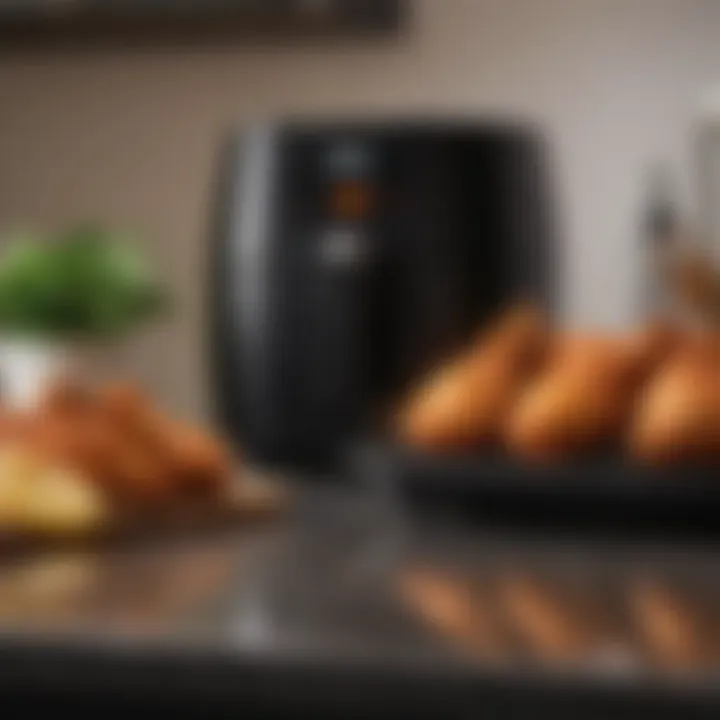
Employing these techniques—basting and incorporating baking powder—will pull your air-fried chicken wings into the realm of perfection. The outcomes not only elevate your culinary skills but also please those who gather around for a meal.
Exploring Flavor Profiles
Understanding and exploring flavor profiles is essential when mastering air fryer chicken wings. Different sauces and marinades transform simple chicken wings into a remarkable dish that can cater to a variety of taste preferences. This section addresses the importance of flavor, highlighting how the right combination enhances the overall experience of eating chicken wings.
Consideration of flavors can also be tied to cultural influences. A diverse range of marinades allows home cooks to experiment and discover what aligns with their preferences. Furthermore, playing with different flavors not only enhances taste but can also complement accompanying ingredients, creating a harmonious meal.
"Flavor is what draws people in, and a signature sauce can elevate even the simplest of ingredients into a culinary masterpiece."
Classic Buffalo Sauce
Classic buffalo sauce is perhaps the most iconic flavor for chicken wings. This sauce typically combines hot sauce, butter, and sometimes additional spices to create a tangy and spicy coating. It is versatile, allowing for adjustments to cater to varying levels of spice tolerance.
When crafting buffalo sauce at home, ensuring the right balance is crucial. Too much hot sauce can overpower the flavor, while not enough can leave the wings tasting bland. Experimenting with the butter-to-sauce ratio can also change the texture and richness of the sauce, making it buttery or more saucy depending on individual preferences.
Buffalo sauce pairs well with ranch or blue cheese dressing, enhancing the flavor profile further. Knowing how to make a traditional buffalo sauce can greatly enhance any gathering where chicken wings are served.
Asian-Inspired Marinades
Asian-inspired marinades offer a fusion of flavors that are richly complex and satisfying. Common ingredients like soy sauce, ginger, garlic, and sesame oil create a savory profile that complements the flavor of chicken wings. Different variations can incorporate elements such as sriracha for heat, honey or brown sugar for sweetness, and rice vinegar for acidity.
One significant benefit of Asian marinades is their ability to tenderize chicken. The acidity from the vinegar and the salt from the soy sauce work together to enhance juiciness and improve texture. Marinating for a few hours or overnight allows the flavors to deeply penetrate the meat, resulting in wings that are both flavorful and tender.
A popular choice is to serve these wings with a side of chopsticks, offering a unique dining experience that echoes traditional Asian culture.
BBQ Glaze Options
BBQ glaze options extend the flavor horizons for chicken wings significantly. Sweet, tangy, and smoky, BBQ glazes can appeal to a wide audience. Traditional BBQ sauce made with tomato paste, vinegar, and spices can be modified with varying amounts of brown sugar or honey to increase sweetness.
Furthermore, regional variations in BBQ sauces, such as Kansas City's thick and sweet sauce or Memphis-style that may lean more on vinegar, allow cooks to provide an authentic touch to their wings. It is worthwhile to experiment with adding ingredients like smoked paprika or mustard to enhance the depth of flavor.
Additionally, using BBQ glaze in the last few minutes of cooking in the air fryer can help in caramelizing the sugars in the sauce, creating a delightful finish that adds a robust layer to the overall taste of the chicken wings.
Incorporating these flavor profiles into your chicken wings not only enhances the meal but also allows for personalization and exploration in the kitchen. Each flavor, from buffalo to Asian and BBQ, carries its own narrative, making your culinary creations richer and more enjoyable.
Serving Suggestions
Serving suggestions play a critical role in the overall experience of enjoying air fryer chicken wings. They contribute to flavor, texture, and the overall aesthetics of your meal. Thoughtful pairings can elevate the humble wing into a star dish for any gathering, making it memorable. Properly presented, the wings become not just a standalone item, but part of a cohesive meal. This section will explore how to maximize the enjoyment of your air fryer chicken wings through ideal accompaniments and dipping sauces.
Pairing with Dipping Sauces
Dipping sauces are essential when it comes to serving chicken wings. The right sauce complements the flavors of the wings and adds a new dimension of taste. Consider providing a variety of sauces to cater to different preferences.
Popular choices include:
- Classic Buffalo Sauce: Spicy and tangy, this is a traditional pairing.
- Ranch Dressing: Offers a creamy, cool contrast.
- Blue Cheese Dressing: Another classic, bringing an intense flavor.
- Honey Mustard: Sweet and tangy, which can appeal to those who prefer milder flavors.
- Soy Sauce: For a salty, umami-rich flavor that pairs well with Asian-inspired wings.
Each sauce brings a unique experience. Allowing guests to mix and match can also add an element of fun. A small serving bowl per sauce works well for sharing.
Accompaniments and Sides
Accompaniments and sides enhance the meal, making it more substantial and appealing. They help round out the flavors and provide texture contrasts that enhance the experience of eating wings.
When planning sides, consider options like:
- Celery and Carrot Sticks: They offer crunch and freshness.
- Coleslaw: A creamy or vinegar-based slaw serves as a refreshing contrast.
- Potato Wedges: Crispy potatoes go nicely with wings, providing additional heartiness.
- Corn on the Cob: A summery, sweet side that contrasts nicely with the spiciness of wings.
Combining these sides with your chicken wings not only adds variety but creates visual appeal on the plate. This also makes for a more filling meal.
A well-considered serving suggestion can create a delightful experience that lingers in the minds of those you share the meal with. Using contrasting flavors, textures, and colors enhances the enjoyment of your air fryer chicken wings, making every bite memorable.
Common Challenges and Solutions
Cooking chicken wings in an air fryer is widely appreciated for its speed and ability to achieve crispy skin without excess oil. However, even with such an efficient appliance, challenges can arise. Addressing common difficulties not only enhances your cooking results but also builds confidence in your abilities. Problems such as under-cooking and managing grease are often encountered by novice and experienced cooks alike. Understanding these issues is essential for mastering the art of air frying chicken wings.
Under-Cooking Dilemmas
One of the most prevalent challenges in cooking chicken wings is ensuring they are cooked thoroughly. Under-cooked wings can pose a health risk due to the presence of harmful bacteria. To avoid this, several precautions are essential.
- Temperature Check: Always use a food thermometer. Chicken wings should reach an internal temperature of 165°F (75°C).
- Proper Placement: Arrange wings in a single layer, ensuring sufficient airflow and even cooking. Avoid overcrowding the basket.
- Time Management: Adjust cooking time based on the size and thickness of the wings. Larger wings may require additional cooking time.
- Stay Alert: Regularly monitor the cooking process. If wings look undercooked, add a few minutes more until they are done.


Following these practices can help eliminate uncertainty, leading to perfectly cooked air-fried wings.
Managing Excess Grease
Another aspect that often surfaces when air frying chicken wings is the management of grease. Even though air frying uses less oil than traditional frying methods, grease can still accumulate.
- Opt for Skin-On Wings: While skin-on wings create richer flavor and texture, they also release more fat. If managing grease is a priority, consider skinless alternatives.
- Drain the Basket: After cooking, allow excess grease to drain off into the collection drawer before serving. This can significantly reduce the overall grease content.
- Paper Towels: Use paper towels to quickly dab surplus grease before serving. While this might seem trivial, it can make a noticeable difference in the end result.
- Correct Cooking Temperature: Maintain a higher temperature during the cooking process. It helps render fat more effectively, reducing excess oil at the end.
Through these practical tips, handling grease becomes a manageable aspect of preparing air-fried chicken wings, ensuring a healthier dish without sacrificing flavor.
"Cooking chicken wings in an air fryer can seem simple, but understanding common challenges elevates your results."
By focusing on these common problems and their solutions, home cooks can enhance their air frying skills. A clear approach to under-cooking and grease management ensures every batch of chicken wings is both safe and scrumptious.
Storage and Reheating
Understanding how to store and reheat air fryer chicken wings is critical for maintaining quality and flavor. Proper storage not only preserves taste but also prolongs the enjoyment of your cooked wings. Furthermore, reheating them correctly ensures that they retain their texture, making them almost as delightful as when they were freshly cooked.
Proper Storage Techniques
After cooking chicken wings, the way you store them will affect their flavor and texture over time. Here are some method to consider:
- Cool Down Before Storing: Allow the wings to cool down to room temperature before sealing them in a container. This prevents condensation which can make them soggy.
- Use Airtight Containers: Opt for airtight glass or plastic containers. This minimizes exposure to air and preserves the wings' moisture and flavor.
- Separate Layers: If you have many wings, consider placing parchment paper between layers to avoid sticking together. This is particularly useful if you plan to reheat them later.
- Use Freezer Bags: For longer storage, consider using freezer bags. Squeeze out as much air as you can before sealing. This technique is excellent for maintaining quality if you wish to store them for more than a few days.
- Label and Date: Always label your storage containers or bags with the date of cooking. This helps you keep track of freshness.
Best Reheating Practices
Reheating chicken wings requires care to avoid overcooking or drying them out. Here are specific methods to consider for optimal results:
- Air Fryer: Using the air fryer is ideal for reheating because it effectively restores crispness. Preheat your air fryer to 350°F (175°C) and then reheat your wings for about 5-7 minutes.
- Oven Method: Preheat the oven to 375°F (190°C). Place the wings on a baking sheet and cover them loosely with foil to retain moisture. Bake for about 10-15 minutes, then uncover for an additional 5 minutes to re-crisp the skin.
- Microwave Caution: If you are in a hurry, the microwave can be used, but it may not yield the best results in terms of crispiness. Use a microwave-safe plate, cover with a damp paper towel, and heat for 1-2 minutes, checking frequently.
"Proper storage and reheating techniques can greatly extend the freshness of your wings while preserving their signature crispy texture."
By considering these tips for storage and reheating, you can enjoy your air fryer chicken wings over multiple meals. Emphasizing these practices ensures that every bite is as delightful as the first.
Health Benefits of Air Frying
Air frying has become an appealing method for cooking, especially for those who seek healthier alternatives to traditional frying. Understanding the health benefits can motivate cooks to consider air frying as their preferred method. This section focuses on the significant advantages that air frying offers, particularly in relation to fat content and nutritional value.
Reduced Fat Content
One of the most notable benefits of air frying is its ability to significantly reduce fat content compared to traditional frying. When you fry food in oil, it absorbs a considerable amount of fat, leading to a high caloric intake. Air fryers, however, use hot air circulation to cook food, requiring little to no oil. This method allows for the development of a crispy exterior without the excess fat.
Studies have shown that air fried chicken wings can contain up to 75% less fat than those deep fried in oil. This reduction not only lowers caloric intake but also contributes to overall heart health. For those monitoring their diets, air frying offers a safer, healthier path while still maintaining satisfying crunch and taste.
"Air frying leads to delicious meals without the guilt of high fat content.”
Retaining Nutritional Value
Another essential aspect of air frying is its ability to preserve the nutritional value of food. Many cooking methods, especially boiling or deep frying, can cause the loss of essential nutrients. In contrast, air frying helps in retaining more of these nutrients, allowing for a healthier meal.
The quick cooking times and the use of minimal oil helps shield foods from excessive heat and long cooking durations. For instance, nutrients such as vitamins A, C, and several B vitamins are less likely to diminish in an air fryer environment. Consequently, when preparing chicken wings, you not only enjoy a flavorful dish but also benefit from the nutritional aspects.
Considering these factors, it is clear that air frying provides a practical solution by merging health benefits with culinary satisfaction. By adopting this cooking style, you can create delicious meals with improved health outcomes.
Culmination
The conclusion serves as a pivotal summation of the insights provided throughout this guide. It reinforces the significance of mastering air fryer chicken wings, especially given their growing popularity in kitchens worldwide. As home cooks continue to seek healthier and simpler cooking methods, air frying emerges as a leading option. The ability to create crispy, flavorful wings with substantially less oil not only benefits health-conscious individuals but also enhances convenience in meal preparation.
Furthermore, this article has highlighted key elements such as ingredient selection, preparation techniques, and cooking settings. Each section contributes to a more comprehensive understanding of the ideal approach to air frying chicken wings. The consideration of various flavors and serving options encourages creativity in the kitchen.
Overall, the importance of the concluding section lies in its capacity to consolidate knowledge and motivate readers to put their newfound skills into practice.
Recap of Key Points
In summary, several crucial points emerge from this guide:
- Air Frying Overview: A brief introduction to air fryers and their benefits.
- Ingredient Quality: Tips for selecting fresh chicken wings and essential seasonings.
- Preparation Techniques: Guidance on cleaning and marinating wings for enhanced flavor.
- Cooking Mastery: Detailed steps for preheating, setting temperature and time, and the actual cooking process.
- Crispiness Techniques: Methods such as basting and using baking powder for the perfect texture.
- Flavor Exploration: Discussion on various sauces and marinades to elevate taste.
- Serving Suggestions: Recommendations for dipping sauces and side dishes to complement wings.
- Addressing Common Issues: Solutions for under-cooking and managing excess grease.
- Storage and Reheating: Best practices for keeping leftovers fresh.
- Health Advantages: Insights into lower fat content and preserved nutrients.
By distilling these points, readers can revisit or reinforce crucial concepts for successful air frying.
Encouragement to Experiment
The kitchen should be a place of exploration and creativity. Encouraging experimentation with chicken wings allows home cooks to expand their culinary repertoire. Mixing different seasonings or adjusting cooking times can lead to unique flavor profiles and textures.
Additionally, trying out alternative ingredients, like plant-based wings or various sauces, can cater to different dietary preferences. The freedom to innovate not only makes the cooking experience enjoyable but also influences personal tastes.
In closing, as readers master the skills outlined, they should feel inspired to challenge themselves with new recipes and styles. Each attempt offers a learning opportunity, setting the stage for improved techniques and even more delicious results.















